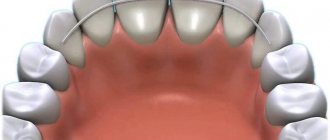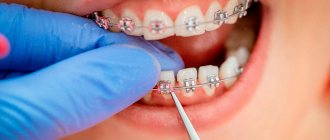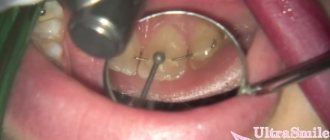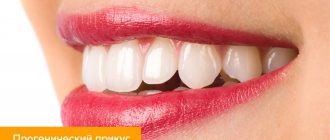Devices of this type are used to confirm the results already achieved and maintain the resulting therapeutic effect until the body completes a morphological or functional restructuring. Under such circumstances, retainers act as a means to reduce the incidence of relapses. The need for their use is justified by the fact that histological processes in bone tissue after external changes are much slower and do not always correspond to the changes that are introduced into the dental cavity under the influence of a special apparatus.
Retention devices are used to hold the dental cavity, an individual tooth in a new position, without limiting the oral cavity. In addition, such a device looks quite aesthetically pleasing and does not exert a force on the patient’s jaw, thereby causing a lot of unpleasant moments.
Removable structures
Very easy to use, they can be removed independently during meals, hygiene procedures, and if therapeutic dental treatment is necessary. Also easy to install back. There are several types:
- Polymer transparent retainers-aligners, reinforced with a metal arch. They fix the position of the teeth along the length of the jaw and are invisible to others. Used constantly, excluding food intake and care procedures.
- Orthodontic plates consist of a plastic base and fixing metal elements. Basically, the designs are worn at home and put on before bed.
- Positioners keep the teeth in the correct position and restore the tone and density of the gum tissue. Made from elastic polyurethane, they are easy to use and do not cause allergic reactions. Show high effectiveness for minor occlusion disorders.
Removable orthodontic appliances are made within 3-7 days using individual impressions.
Features of the retention period
Duration. The period of use of retention devices is determined by the treating orthodontist. The more the dental system has been changed, the longer it will be. Additionally, it is influenced by the state of the dental system, the speed of adaptation of its tissues to the new position of the teeth, and other features. The retention period can last as long as the main phase of treatment, or longer.
Daily hygiene. This is done in the same way as when using braces. The constant use of metal plates fixed to the surface of the enamel can increase the risk of its demineralization, accumulation of soft plaque, and the appearance of tartar. To keep your teeth healthy, you need to visit the dentist once every six months for a preventive examination, professional hygiene, and enamel remineralization. These visits are combined with control examinations by an orthodontist, who can adjust the retention apparatus, change recommendations for its use, etc. If a non-removable retainer comes off, causes discomfort, etc., an orthodontist is visited urgently.
Additional treatment. Together with mouthguards or retainers, functional orthodontic devices (regulators, bionators, activators, etc.) can be used at the final stage of treatment. They are installed to finally align the position of the teeth while the adaptation process is underway.
During the retention period, the shape of the dentition no longer changes, and there will be no visible, noticeable results at this stage of treatment. It is important so that the teeth acquire a stable position, and the dental system itself successfully adapts to it.
Dentists at the Dentospas clinic use individually manufactured devices during the retention period, which ensures control over the stability of the teeth. This ensures that the results of orthodontic treatment will not be lost, and the patient’s smile will remain beautiful for a long time.
Fixed retainers
They are represented by a thin metal arch, which is point-fixed with composite material to the inner surface of each tooth. They are installed immediately after the braces are removed, the adjustment time does not exceed a week. It must be remembered that the results of corrective treatment can only be maintained by constantly wearing retention splints! Neglecting the orthodontist's recommendations leads to deformations of the dentition and bite.
Installation Features
Retainers are installed on the day the braces are removed. Fixation is carried out after polishing the enamel and/or professional hygiene. For better adhesion, a special composition is applied to the surface of the teeth. The installation of removable devices is preceded by taking impressions and making mouth guards, positioners or orthodontic plates in the laboratory.
Instructions for the care and wearing of a removable retention device
- 1. On the first day of wearing a retainer, you may experience slight pain in the area of some teeth. This is a temporary phenomenon that goes away after a few hours.
- 2. In the first days after installing the mouth guard, increased salivation is possible, which goes away after 1-2 days.
- 3. There may be a slight change in diction in the first days after installing the mouth guard. Diction will be fully restored after 2-3 days of regularly wearing the mouth guard.
- 4. If during wearing you notice that the edges of the retainer scratch the mucous membrane of the tongue or cheeks, then in this case you need to contact your doctor to have these sharp edges corrected.
- 5. Under no circumstances should any food be consumed in a removable retainer. This can lead to rapid breakdown of the device.
- 6. You cannot smoke with a mouthguard in your mouth or take coloring liquids (red wine, juices, Coca-Cola, etc.). This may cause the mouthguard to lose its clear properties.
- 7. Do not immerse the mouthguard in hot liquids (more than 40 degrees). This may lead to its deformation.
- 8. In those moments when it is necessary to remove the mouth guard, watch where it is located, because Most often, its loss occurs in cafes, bars and restaurants, during meals.
- 9. When removing the mouthguard, do not put it in your clothing pockets without a special container; if you forget about it, you can easily damage it.
- 10. You need to clean your mouthguard 2 times a day with a toothbrush and soap. You need to be very careful when cleaning. Significant bending of the mouth guard can lead to cracks in it.
- 11. If you have lost your mouth guard, you must urgently make an appointment with a doctor to take impressions and make a new mouth guard. This needs to be done as quickly as possible, because... Without a mouth guard, your teeth can quickly change their position and not for the better.
- 12. If you are far from the clinic, or your doctor is on vacation, other doctors at our clinic, or any dental institution in your place of stay, can take impressions and make plaster models for you.
- 13. The service life of the mouth guard is about 1 year, after which it is necessary to make a new mouth guard. The patient pays for a new mouthguard. In cases where a mouth guard is lost or broken, the patient bears the cost of making a new mouth guard.
PS You may also find it useful to learn how to care for braces.
If you were treated in another clinic, and for some reason you did not have a retention mouthguard installed, and after reading this page you have a desire to maintain the result, then we can make a retention mouthguard for you.
General care recommendations
The retention period is the most important and integral part of the technology for correcting occlusion. The success of treatment largely depends on the patient’s conscientious adherence to the doctor’s recommendations.
- Before fixing them on the teeth, removable retainers are rinsed with a soapy solution; in the morning and before bed, it is recommended to clean them with a special brush with a low-abrasive paste. Once or twice a week, removable structures are soaked in an antibacterial solution. To protect against damage and deformation, tires should be stored in a lockable case.
- Oral care with permanently installed retainers is carried out using traditional methods. For thorough cleaning of mineralized plaque and food debris, threads, brushes, and irrigators are used.
- An indispensable condition for oral health is visiting the orthodontist at least twice a year. An emergency visit to the dentist is necessary in case of discomfort and pain, as well as in case of damage to the aligners, plates or breakage of the metal arch.
Instructions for the care and monitoring of a fixed retention device
- 1. Monitor the integrity of the permanent retainer; periodically check it with your finger in front of a mirror with good lighting. If you feel the retainer moving around any of your teeth, this is a reason to visit your orthodontist. By examining the condition of the retainer in the mirror, you can independently determine the absence of material on one of the teeth, which also requires a slight correction by your doctor.
- 2. In a situation where a non-removable retainer has completely peeled off from all teeth, this is critical and requires an urgent visit to the doctor. If a non-removable retainer comes off completely, it is mandatory to wear a removable retention mouth guard around the clock until you visit a doctor and install the retainer in its original location.
- 3. In no case should you use a toothpick or other objects to pick out food debris from under the retainer; it is more advisable to use a toothbrush.
- 4. Approximately once every 6 months it is necessary to have professional teeth cleaning (if ultrasound is used during cleaning, it is very important that the doctor has sufficient experience working with orthodontic patients). Incorrect operation of the ultrasonic tip in the retainer area can lead to damage to its integrity.
Advantages of the Alfa-Vid clinic
The Alfa-Vid Dental Center invites patients in need of bite correction to a free consultation. At the initial appointment, the doctor will carefully examine the oral cavity and, depending on the clinical case, will offer the best option for retention treatment. We guarantee:
- compliance with international quality and safety standards;
- individual approach;
- comprehensive problem solving.
If necessary, the patient has access to emergency assistance from doctors of related dental specialties (therapist, surgeon, etc.). The clinic is equipped with advanced European-level equipment, and dentists use high-quality materials in their work.
The final stage of treatment
Once each tooth has taken its place, therapy cannot be stopped. Indeed, over time, the curvature may develop again, and then all efforts will be useless. It is important to securely fix them in the new position. This is the main purpose of using retention devices. They must be used until the adaptation stage is completed (the period is determined by the doctor). When worn, they are imperceptible and hardly noticeable. It's not difficult to get used to them. Care does not take much time, there is no negative impact on the enamel or gums, and, as practice shows, the result is not long in coming.
What is an orthodontic retainer
An orthodontic retainer is a device designed to fix teeth in the achieved position. Its functional characteristics do not include changing the position of the teeth, but only stabilizing the result. The use of such systems makes it possible to prevent teeth from returning to the position they occupied before the correction began. Retainers also play a preventive role, signaling the emerging unwanted displacement of teeth to their previous position. Problems that arise with the use of devices are a factor in reducing the effect of the correction performed. In this case, an unscheduled consultation with an orthodontist will help to establish the true cause of problems in the operation of the systems and promptly correct the identified violations.
Types of retention systems
Orthodontic retainers are varied; there are removable and non-removable systems.
Depending on these characteristics, they are visible, or their operation goes unnoticed. The installation option is selected by the orthodontist, depending on the initial problem and clinical case. The most typical example of a non-removable retention system is a wire arch. Using dental glue, it is fixed to the inside of the teeth. Its use is completely invisible. To ensure better adhesion, a special solution is applied to the teeth, giving the surface some roughness. To install the structure, the method of drilling a groove can be used, followed by laying the structure in it and strengthening it with a composite.
It is especially important to use this option of a non-removable retention system if, in addition to orthodontic disorders, there is damage to periodontal tissue. Thanks to the rigid fixation on the teeth, it is possible to limit their mobility and increase stability.
The advantages of permanent retainers are:
- Invisibility of this stage of correction.
- High efficiency, ensured by the fact that the metal arc solves the task assigned to it around the clock, on an ongoing basis.
- There are no problems with maintaining discipline, because the device cannot be lost or forgotten to install.
- Comfortable feeling. The process of getting used to using a wire arc is almost eliminated. The design does not interfere with any physiological processes. There are no violations of diction, food intake is carried out without any peculiarities.
Disadvantages of permanent retainers:
- Some complication of hygiene procedures in the places where the structure is installed. To ensure the desired result, the patient has to turn to additional devices, brushes, and irrigators. Professional cleaning is recommended twice a year.
- Despite the fact that hypoallergenic material, dental steel, is used in the manufacture of the devices, there is still a slight risk of developing an allergic reaction to the metal.
- The possibility of the structure coming off due to chewing hard food is not completely excluded. In the event of a mechanical failure, the arch should be immediately installed in its original place, so a second visit to the orthodontist will be required.
The patient can independently remove and install removable retainers in the oral cavity.
Taking these features into account, the doctor clearly determines the operating conditions of the devices. As a rule, they remain in the oral cavity for a longer time at first. As the situation stabilizes, the period of wearing them decreases. However, the decision to relax operating requirements lies solely with the orthodontist. When not in use, the devices are kept in a special container. This storage method will avoid contamination or breakage.
Removable retainers are available in the following options:
- A plate in the form of a plastic base with metal arcs attached to it.
- Silicone mouthguards are a transparent structure that follows the shape of the dentition. They are made from biopolymer materials using impressions and fit tightly to the teeth. The fundamental difference from aligners is the function they perform. Removable retainers are not designed to allow tooth movement. They are used only to stabilize them in the desired position.
- Double-jaw retention splints, which are worn on both jaws at once during sleep.
Basic rules of wearing and care
To maintain the results of bite correction for a long time, follow simple rules.
- Regularly undergo preventive examinations with an orthodontist to prevent displacement of teeth.
- Carefully monitor the condition of removable and non-removable structures. If they come off, become cracked, or begin to cause discomfort, consult your doctor immediately.
- When wearing permanent retainers, pay special attention to oral hygiene. Use not only a brush to brush your teeth, but also special brushes to avoid plaque accumulation in hard-to-reach places. A specialist will help you choose suitable care products.
- Remove trays and plates when eating or smoking, as food coloring and tobacco smoke can cause the plastic to become cloudy.
Why is retention needed?
- Braces have a mechanical effect on the bone and mucous tissues of the periodontal tissues, and after removing the plates, time is needed for the reorganization of these tissues.
- At the end of the course of wearing braces, the teeth are in an unstable position, pressure from the soft tissue creates a risk of relapse.
- In adolescents, changes associated with tooth growth can also cause some changes in the bite after treatment, so retainers become a necessary measure.











